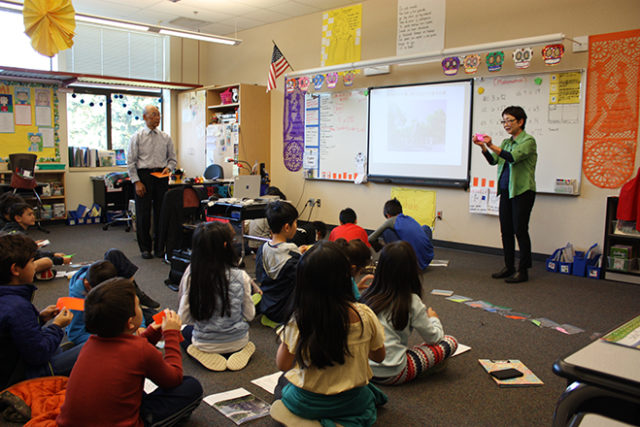by Misa Murohashi,
“What do you know about Hiroshima?” Tsukasa Namekata, president of Seattle Hiroshima Club, asked the question to grade school students at Yotsuba Gakuin’s Japanese Saturday school in Bellevue. On October 21st, Namekata and another club member, Kimie Kuramoto, held a special class about Hiroshima for the young students group. The group discussed Itsukushima Shrine (A UNESCO World Heritage Site in Hiroshima), Okonomiyaki, Hiroshima oysters and, of course, the atomic bomb, which most of the students knew about. This may have been a difficult topic for this roomful of American kids raised by Japanese parents.
Seattle Hiroshima Club was founded in 1900 by first generation immigrants from Hiroshima Prefecture. According to HistoryLink.org, “Most of the Japanese immigrating to the Northwest came from rural regions in Hiroshima, Yamaguchi, and Okayama prefectures.” Hiroshima Club’s activities stopped during World War II, but resumed in 1948. The Club was very active in raising money to help rebuild Hiroshima in the wake of the bombing. “Today there are about 150 members, including second- and third-generation Nikkei and Issei who came to the US after the war,” Namekata said.
In 2010, Hiroshima Club recorded film interviews with seven A-bomb survivors living in Seattle and added English subtitles. You can find these interviews on the club’s website. The club also works to make sure these A-bomb victims are heard by people in Seattle, bringing home a lesson of peace.
The interviews were aired at the special class at Yotsuba Gakuin. The students watched a video where Namekata interviewed a former nursing student Momoe Hachiya. Just after the bomb, Hachiya spent a month treating A-bomb victims at Hiroshima Red Cross Hospital. The hospital’s building was damaged from the bomb but did not collapse, so it became an emergency hospital for victims. Hachiya recalled the victims with dark black burns all over their bodies, in agony as they died. “I can’t find words to describe the misery,” she said. Students also watched survivor Rikuko Tanaka tell her story. She was trapped under a collapsed building. “If I die here, I would like to let somebody know about my death,” she remembered thinking. She talked of her vivid memories facing imminent death.
After the videos were viewed, Namekata told the students, “When the A-bomb was dropped, Okinawa had fallen into the hands of American soldiers, and the mainland’s large cities were reduced to burning fields by the air raids. I don’t know if dropping the atomic bomb was necessary.” Within a year after the A-bombs were dropped, it is calculated that about 120,000 in Hiroshima and 75,000 in Nagasaki had died (actual numbers are unknown due to confusion after the bomb). The students had thoughtful looks as Kuramoto began to explain the origami prayer for peace and handed out colored paper. Their smiles returned as they folded their paper cranes. Today, Japan and the US have extremely friendly relations. For children growing up with a connection to both countries, this special lesson held deep meaning.







